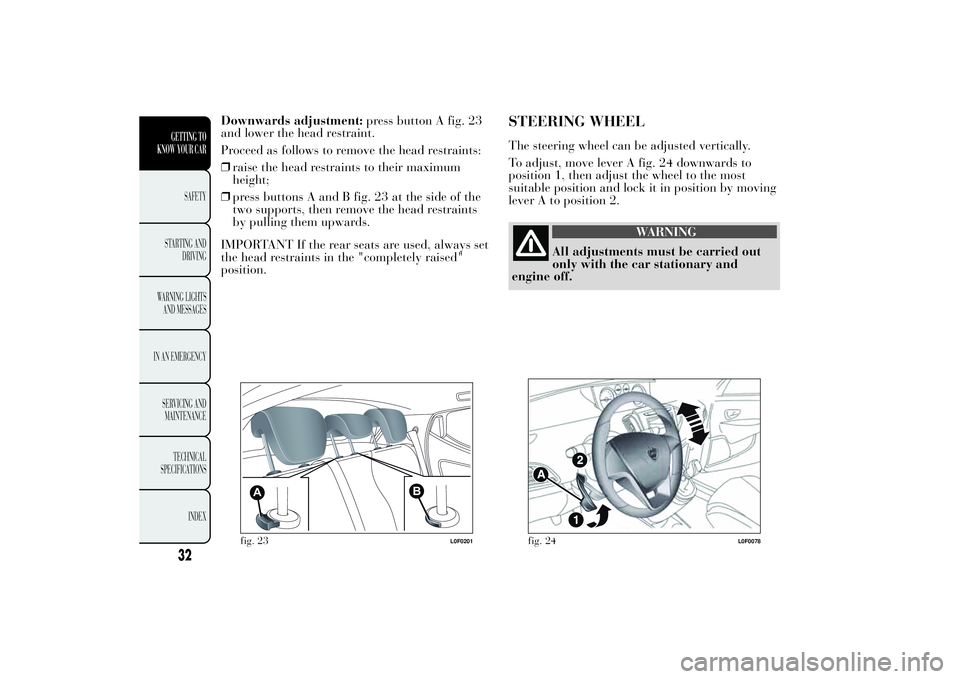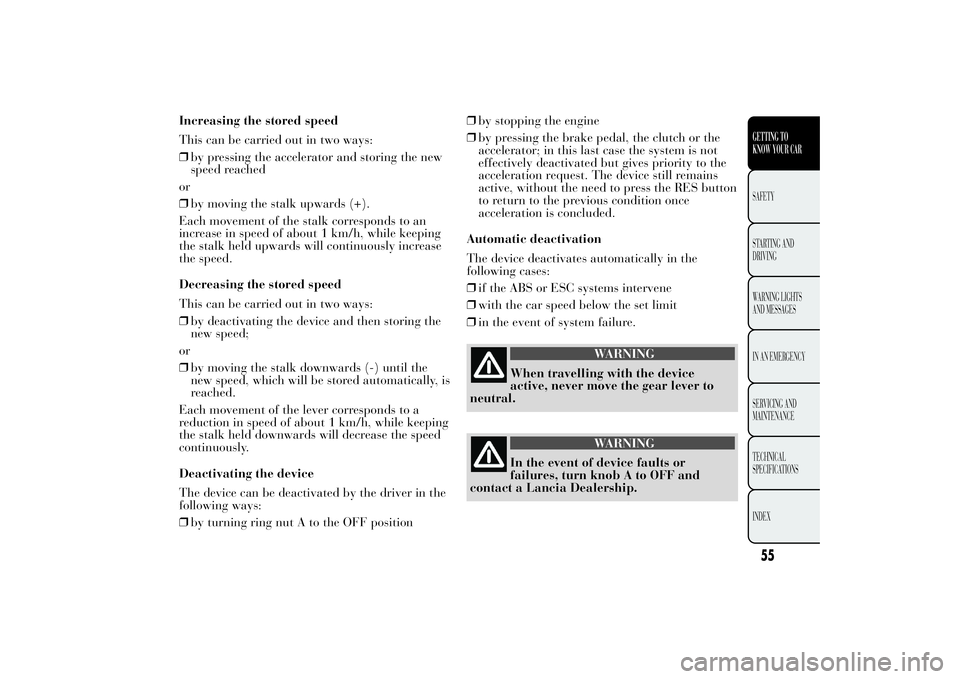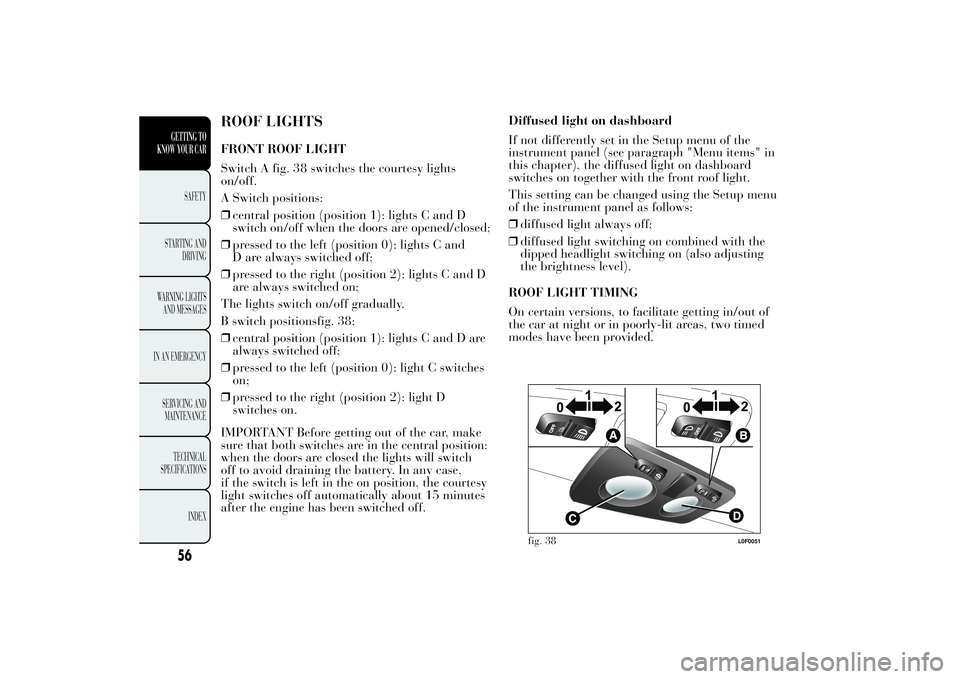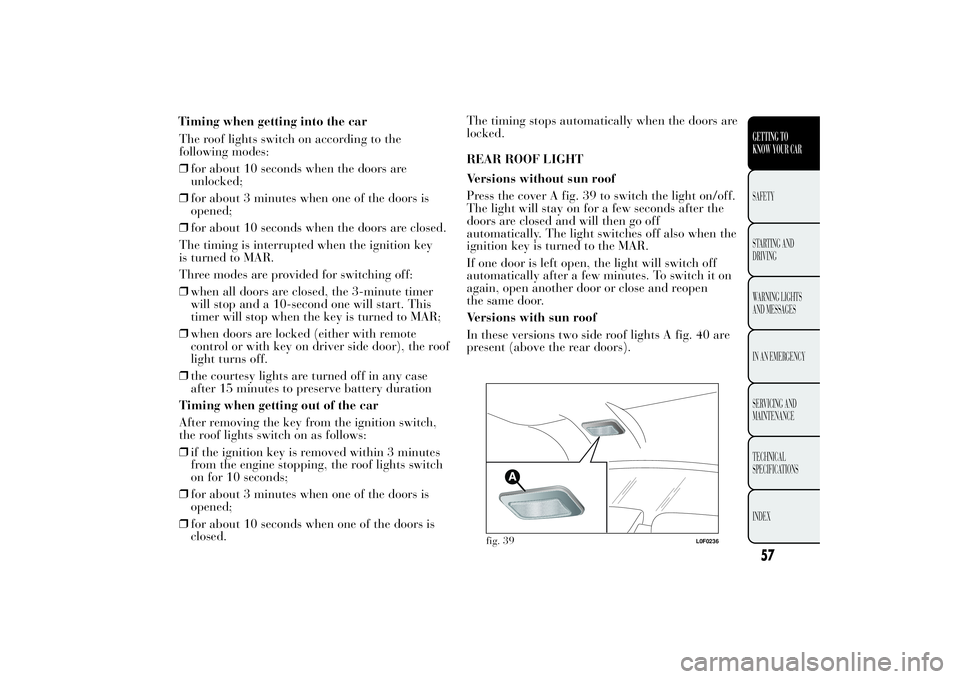engine Lancia Ypsilon 2011 Owner handbook (in English)
[x] Cancel search | Manufacturer: LANCIA, Model Year: 2011, Model line: Ypsilon, Model: Lancia Ypsilon 2011Pages: 299, PDF Size: 13.35 MB
Page 34 of 299

Downwards adjustment:press button A fig. 23
and lower the head restraint.
Proceed as follows to remove the head restraints:
❒raise the head restraints to their maximum
height;
❒press buttons A and B fig. 23 at the side of the
two supports, then remove the head restraints
by pulling them upwards.
IMPORTANT If the rear seats are used, always set
the head restraints in the "completely raised"
position.
STEERING WHEELThe steering wheel can be adjusted vertically.
To adjust, move lever A fig. 24 downwards to
position 1, then adjust the wheel to the most
suitable position and lock it in position by moving
lever A to position 2.
WARNING
All adjustments must be carried out
only with the
car stationary and
engine off.
A
B
fig. 23
L0F0201
fig. 24
L0F0078
32GETTING TO
KNOW YOUR CAR
SAFETY
STARTING
AND
DRIVING
WARNING LIGHTS
AND MESSAGES
IN AN EMERGENCY
SERVICING AND
MAINTENANCE
TECHNICAL
SPECIFICATIONS
INDEX
Page 40 of 299

C Air distribution knob fig. 32
toward the body and the side windowstoward the body, the side windows and the
feettoward the feet onlytoward the feet and the windscreentoward the windscreen only
D Heated rear window activation/deactivation
button fig. 32.
When the function is active, the LED on the
button is lit up.
In order to maintain battery efficiency, the
function is automatically deactivated after about
20 minutes.
E Fan speed knob and climate control system
activation/deactivation fig. 32. Press the knob
to activate the climate control system; the
LED on the knob switches on. This enables
rapid cooling of the passenger compartment.
NoteTo stop the air flow from the vents turn the
knob to 0.
F climate control compressor activation/
deactivation button fig. 32.
Fast windscreen and front side window
demisting/defrosting (MAX-DEF)
Proceed as follows:
❒turn knob A to the red section;❒move slider B to
;
❒turn knob C to
;
❒turn knob E to 4 (maximum fan speed).
IMPORTANT The climate control system is very
useful for speeding up demisting since it
dehumidifies the air. Adjust the controls as
described above and press button
to activate the
climate control system (the LED on the button
will light up).
ADDITIONAL HEATER
(for versions/markets, where provided)
This device speeds up passenger compartment
warming when it is very cold. The additional
heater turns off automatically after reaching the
required comfort conditions.
The heater only works if the outside temperature
and engine coolant temperature are low. The
heater will not activate if the battery voltage is too
low.
SYSTEM MAINTENANCE
In winter, the climate control system must be
turned on at least once a month for about
10 minutes. Have the system inspected at a
Lancia Dealership before the summer.
38GETTING TO
KNOW YOUR CAR
SAFETY
STARTING
AND
DRIVING
WARNING LIGHTS
AND MESSAGES
IN AN EMERGENCY
SERVICING AND
MAINTENANCE
TECHNICAL
SPECIFICATIONS
INDEX
Page 44 of 299

Manual selections always have higher priority over
automatic settings and are stored until the user
switches the system back to automatic control
expect for cases in which the system intervenes for
particular safety-related reasons. You can adjust
one function manually without affecting the
automatic control of the others.
The amount of air introduced into the passenger
compartment is not affected by car speed; it is
regulated by the fan, which is controlled
electronically.
The temperature of the air introduced is always
controlled automatically, according to the
temperature set in the display for the driver and
the front passenger (except when the system is off
or in certain conditions when the compressor is
deactivated).
The system allows the following to be set or
adjusted manually:
❒driver/front passenger side air temperature
❒fan speed (continuous variation)
❒air distribution to 5 positions (driver/passenger)
❒compressor activation
❒rapid defrosting/demisting function
❒air recirculation
❒heated rear window
❒system deactivation.SWITCHING ON THE CLIMATE CONTROL
SYSTEM
The system can be switched on in various ways; it
is however advisable to press the AUTO button
and set the desired temperature on the display.
The climate control system allows you to
customise the temperatures requested (driver side
and passenger side) with a maximum difference
of 7°C.
The climate control system compressor works only
with the engine running and with an outside
temperature of above 4°C.
AUTOMATIC CLIMATE CONTROL SYSTEM
OPERATION
Press the AUTO button; the system will
automatically adjust:
❒the amount of air introduced into the passenger
compartment;
❒the distribution of the air in the passenger
compartment;
cancelling all previous manual adjustments.
During climate control system automatic
operation, the word AUTO appears on the display.
During automatic operation it is still possible to
adjust the temperatures set and carry out the
following operations manually:
❒fan speed adjustment
❒air distribution selection
42GETTING TO
KNOW YOUR CAR
SAFETY
STARTING
AND
DRIVING
WARNING LIGHTS
AND MESSAGES
IN AN EMERGENCY
SERVICING AND
MAINTENANCE
TECHNICAL
SPECIFICATIONS
INDEX
Page 47 of 299

Compressor deactivation
❒
symbol on display disappears;
❒internal air recirculation excluded;
❒AQS function disabled.
With the climate control compressor switched off,
air cannot be introduced into the passenger
compartment that has a lower temperature than
the outside air; in this case the
symbol in the
display will flash.
The deactivation of the climate control compressor
is memorised even after the engine has stopped.
To reactivate the climate control compressor, press
button
or AUTO again: if you press AUTO,
the other manual settings will be cancelled.
AIR DISTRIBUTION SELECTION
Press one or more of buttons A fig. to manually
select one of the possible air distribution settings
for the passenger compartment:
Air flow to the windscreen and front side
window diffusers to demist/defrost them.Air flow to the front and rear footwell
diffusers. This air distribution allows the
passenger compartment to be warmed up
quickly.+
+
Air flow distribution between
front and rear diffusers,
centre/side dashboard diffusers,
rear diffuser and windscreen
and front side window
demisting/defrosting diffusers.
Air flow distribution to centre/side dashboard
diffusers (passenger's body).+
Air flow distributed between footwell
diffusers and windscreen and front side
window defrosting/demisting diffusers.
This distribution setting allows the
passenger compartment to be warmed
effectively and prevents the windows
from misting.
+
Air flow distribution between footwell
diffusers (hotter air) and centre/side
dashboard diffusers and rear diffuser
(cooler air).
+
Air flow distribution between
centre/side dashboard vents, rear
diffuser and windscreen and front side
window demisting/defrosting diffusers.
This distribution setting ventilates
the passenger compartment well and
prevents the windows from misting up.
IMPORTANT For the climate control system to
function, at least one of the buttons A must be
operated fig. . The system does not allow the
deactivation of all the buttons A.
IMPORTANT Push the OFF button to turn the
climate control system back on: in this way, all
operating conditions memorised before switching
off are restored.
To restore automatic control of the air distribution
after a manual selection, press the AUTO button.
45GETTING TO
KNOW YOUR CARSAFETY
STARTING
AND
DRIVING
WARNING LIGHTS
AND MESSAGES
IN AN EMERGENCY
SERVICING AND
MAINTENANCE
TECHNICAL
SPECIFICATIONS
INDEX
33 33
Page 51 of 299

MAIN BEAM HEADLIGHTS
To switch on the main beam headlights, with ring
nut in position
, push the stalk forward toward
the dashboard (unstable position). The
warning light will come on in the instrument
panel.
When the stalk is released, the lights deactivate,
the main beam headlights reactivate and thewarning light switches off.
It is not possible to switch on the main beam
headlights in fixed mode if the automatic lighting
control system is active.
FLASHING
You can flash the headlights by pulling the stalk
towards the wheel (unstable position). Thewarning light will come on in the instrument
panel.
DIRECTION INDICATORS
Bring the stalk to the (stable) position:
upwards:right-hand direction indicator
activation;
downwards:left-hand direction indicator
activation.
Warning light
or
should flash in the
instrument panel. The indicators switch off
automatically when the steering wheel is
straightened.Lane change function
If you wish to signal a lane change, put the left
stalk in the unstable position for less than half a
second. The direction indicator on the selected
side flashes three times and then switches off
automatically.
“FOLLOW ME HOME” DEVICE
This allows the space in front of the car to be lit
up for a certain period of time.
Activation:with the ignition key on STOP or
removed, pull the stalk towards the steering wheel
within 2 minutes from when the engine is turned
off.
At each single movement of the stalk, the lights
will remain on for an extra 30 seconds up to a
maximum of 210 seconds; then the lights are
switched off automatically.
Each time the stalk is operated, the
warning
light on the instrument panel switches on and the
display also shows a message and how long the
function will remain active.
The
warning light switches on when the stalk
is first moved and stays on until the function is
automatically deactivated. Each time the stalk is
activated it increases the time that the lights
remain on.
Deactivation:keep the stalk pulled towards the
steering wheel for more than two seconds.
49GETTING TO
KNOW YOUR CARSAFETY
STARTING
AND
DRIVING
WARNING LIGHTS
AND MESSAGES
IN AN EMERGENCY
SERVICING AND
MAINTENANCE
TECHNICAL
SPECIFICATIONS
INDEX
Page 53 of 299

Move the stalk upwards (unstable position) to
limit operation to the time for which the stalk is
held in this position. When released, the stalk will
return to its default position and the wiper will
be automatically stopped.
With the ring nut A fig. 35 in position
, the
windscreen wiper will automatically adapt
operating speed to the speed of the vehicle.
With the windscreen wipers operational, if reverse
gear is engaged, the rear window wiper is
automatically activated.
Never use the windscreen wipers to
remove layers of snow or ice from the
windscreen. In such conditions, the
windscreen wipers may be subjected to
excessive stress and the motor protection,
which prevents operation for a few seconds,
may intervene. If operation is not restored
(even after using the key to restart the engine),
contact a Lancia Dealership.Do not operate the windscreen wiper
with the blades lifted from the
windscreen."Smart washing" function
Pull the lever towards the steering wheel (unstable
position) to activate the windscreen washer.
Keeping the stalk pulled for more than half a
second, with just one movement it is possible to
operate the washer jet and the wiper at the same
time.
The wiper stops working three strokes after the
stalk is released.
A further stroke after approximately six seconds
completes the wiping cycle.
RAIN SENSOR
(for versions/markets, where provided)
The rain sensor is located behind the rear view
mirror in contact with the windscreen fig. 36 and
has the purpose of automatically adjusting the
frequency of the windscreen wiper strokes
depending on the intensity of the rain during
intermittent operation.
The sensor has an adjustment range that varies
progressively from wiper still (no stroke) when the
windscreen is dry, to wiper at first continuous
speed (slow continuous operation) with intense
rain.
51GETTING TO
KNOW YOUR CARSAFETY
STARTING
AND
DRIVING
WARNING LIGHTS
AND MESSAGES
IN AN EMERGENCY
SERVICING AND
MAINTENANCE
TECHNICAL
SPECIFICATIONS
INDEX
Page 57 of 299

Increasing the stored speed
This can be carried out in two ways:
❒by pressing the accelerator and storing the new
speed reached
or
❒by moving the stalk upwards (+).
Each movement of the stalk corresponds to an
increase in speed of about 1 km/h, while keeping
the stalk held upwards will continuously increase
the speed.
Decreasing the stored speed
This can be carried out in two ways:
❒by deactivating the device and then storing the
new speed;
or
❒by moving the stalk downwards (-) until the
new speed, which will be stored automatically, is
reached.
Each movement of the lever corresponds to a
reduction in speed of about 1 km/h, while keeping
the stalk held downwards will decrease the speed
continuously.
Deactivating the device
The device can be deactivated by the driver in the
following ways:
❒by turning ring nut A to the OFF position❒by stopping the engine
❒by pressing the brake pedal, the clutch or the
accelerator; in this last case the system is not
effectively deactivated but gives priority to the
acceleration request. The device still remains
active, without the need to press the RES button
to return to the previous condition once
acceleration is concluded.
Automatic deactivation
The device deactivates automatically in the
following cases:
❒if the ABS or ESC systems intervene
❒with the car speed below the set limit
❒in the event of system failure.
WARNING
When travelling with the device
active, never move
the gear lever to
neutral.
WARNING
In the event of device faults or
failures, turn knob
A to OFF and
contact a Lancia Dealership.
55GETTING TO
KNOW YOUR CARSAFETY
STARTING
AND
DRIVING
WARNING LIGHTS
AND MESSAGES
IN AN EMERGENCY
SERVICING AND
MAINTENANCE
TECHNICAL
SPECIFICATIONS
INDEX
Page 58 of 299

ROOF LIGHTSFRONT ROOF LIGHT
Switch A fig. 38 switches the courtesy lights
on/off.
A Switch positions:
❒central position (position 1): lights C and D
switch on/off when the doors are opened/closed;
❒pressed to the left (position 0): lights C and
D are always switched off;
❒pressed to the right (position 2): lights C and D
are always switched on;
The lights switch on/off gradually.
B switch positionsfig. 38:
❒central position (position 1): lights C and D are
always switched off;
❒pressed to the left (position 0): light C switches
on;
❒pressed to the right (position 2): light D
switches on.
IMPORTANT Before getting out of the car, make
sure that both switches are in the central position:
when the doors are closed the lights will switch
off to avoid draining the battery. In any case,
if the switch is left in the on position, the courtesy
light switches off automatically about 15 minutes
after the engine has been switched off.Diffused light on dashboard
If not differently set in the Setup menu of the
instrument panel (see paragraph "Menu items" in
this chapter), the diffused light on dashboard
switches on together with the front roof light.
This setting can be changed using the Setup menu
of the instrument panel as follows:
❒diffused light always off;
❒diffused light switching on combined with the
dipped headlight switching on (also adjusting
the brightness level).
ROOF LIGHT TIMING
On certain versions, to facilitate getting in/out of
the car at night or in poorly-lit areas, two timed
modes have been provided.
fig. 38
L0F0051
56GETTING TO
KNOW YOUR CAR
SAFETY
STARTING
AND
DRIVING
WARNING LIGHTS
AND MESSAGES
IN AN EMERGENCY
SERVICING AND
MAINTENANCE
TECHNICAL
SPECIFICATIONS
INDEX
Page 59 of 299

The roof lights switch on according to the
following modes:
❒for about 10 seconds when the doors are
unlocked;
❒for about 3 minutes when one of the doors is
opened;
❒for about 10 seconds when the doors are closed.
The timing is interrupted when the ignition key
is turned to MAR.
Three modes are provided for switching off:
❒when all doors are closed, the 3-minute timer
will stop and a 10-second one will start. This
timer will stop when the key is turned to MAR;
❒when doors are locked (either with remote
control or with key on driver side door), the roof
light turns off.
❒the courtesy lights are turned off in any case
after 15 minutes to preserve battery duration
Timing when getting out of the car
After removing the key from the ignition switch,
the roof lights switch on as follows:
❒if the ignition key is removed within 3 minutes
from the engine stopping, the roof lights switch
on for 10 seconds;
❒for about 3 minutes when one of the doors is
opened;
❒for about 10 seconds when one of the doors is
closed.The timing stops automatically when the doors are
locked.
REAR ROOF LIGHT
Versions without sun roof
Press the cover A fig. 39 to switch the light on/off.
The light will stay on for a few seconds after the
doors are closed and will then go off
automatically. The light switches off also when the
ignition key is turned to the MAR.
If one door is left open, the light will switch off
automatically after a few minutes. To switch it on
again, open another door or close and reopen
the same door.
Versions with sun roof
In these versions two side roof lights A fig. 40 are
present (above the rear doors).
fig. 39
L0F0236
57GETTING TO
KNOW YOUR CARSAFETY
STARTING
AND
DRIVING
WARNING LIGHTS
AND MESSAGES
IN AN EMERGENCY
SERVICING AND
MAINTENANCE
TECHNICAL
SPECIFICATIONS
INDEX
Timing when getting into the car
Page 62 of 299

CENTRAL LOCKING
Press button
fig. 45 to lock all the doors
simultaneously (the LED on the button will light
up when the doors are locked). Locking takes
place irrespective of the position of the ignition
key.
DUALDRIVE ELECTRIC POWER STEERING
(for versions/markets, where provided)
Press the CITY button fig. 46 to activate the
function (see paragraph "Dualdrive electric power
steering" in this chapter). When this function is
active, the word CITY on the instrument panel
will light up. To deactivate the function press the
button again.ECO FUNCTION
(for versions/markets, where provided)
Press the ECO button fig. 47 for at least 5 seconds
to activate the function.
When the ECO function is activated, the car is set
for city driving, characterised by less effort on
the steering wheel (Dualdrive system on) and
reduced fuel consumption. When this function is
activated, the word ECO on the display will light
up on some versions.
This function stays in the memory and, when the
vehicle is started again, the system keeps the
setting it had before the engine was stopped. Press
the ECO button again to deactivate the function
and restore the normal driving setting.
fig. 45
L0F0081
fig. 46
L0F0043
60GETTING TO
KNOW YOUR CAR
SAFETY
STARTING
AND
DRIVING
WARNING LIGHTS
AND MESSAGES
IN AN EMERGENCY
SERVICING AND
MAINTENANCE
TECHNICAL
SPECIFICATIONS
INDEX